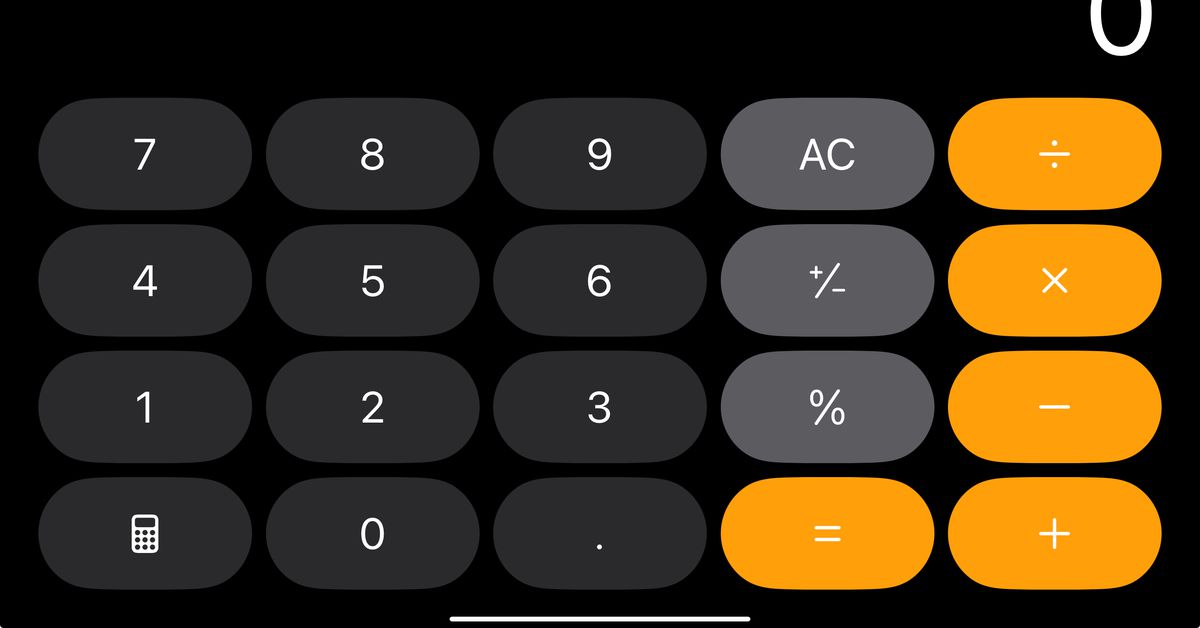The new Calculator app in iPadOS 18 isn’t impressive at first glance. When I installed the new OS, now in public beta, I tapped the calculator icon expecting something that looked uniquely tablet-focused and powerful. I have the Calculator app on the iPhone – just a little bigger. It’s a nice addition to the iPad, sure, but there’s nothing here that took 14 years.
However, the Calculator app doesn’t really matter. I suspect you will hardly ever use it. What is actually extremely cool and innovative about iPadOS 18 and iOS 18 is that it has a calculator built into the operating system itself. Tap the text box in Messages and type “225/4=” and it will automatically tell you that your friend owes you $56.25. You can enter your equation in the body of the email, then tap it to replace it with just the final answer. So far this works in any text field, but only in Apple’s built-in apps; I suspect we’ll see it everywhere when apps are updated. It’s a feature that instantly becomes second nature.
But at least on the iPad, Math Notes really shines. Rather than forcing you to work within the confines of calculator buttons, Math Notes lets you do your arithmetic however you like. You can create a math note from the Calculator app, but the easier strategy is to just open the Notes app and start drawing. Type “56 + 48 + 35 * 4 / 6 =” and a second or two after you type the equal sign, the answer pops up (127.33, in case you were wondering). Write a bunch of numbers in a column, draw a horizontal line underneath, and Notes will automatically sum them up for you. Change a number and it will change the total.
You can do some impressively weird things in Math Notes, including solving equations and generating graphs. Its ability to work with variables is the most impressive thing I’ve seen: if you write your equation and then change a variable, it will rewrite all your answers and redo all your graphs in real time. A lot of the more complicated stuff is great for students and physicists and maybe not much else, but it’s a lot of fun to play with. Oh, and fair warning: like any AI system, it won’t be right all the time. YouTube is already full of funny examples of math notes that get things wrong.
Even at its best, Math Notes is extremely demanding. It requires you to write neatly and carefully, for starters, which was a challenge for my terrible handwriting. If the iPad doesn’t recognize a number or letter in an equation, it adds a dashed red frame to the unknown bit and essentially asks you to try again. (I’ve had pretty good luck with number recognition, for what it’s worth, and a much worse experience with letters and other symbols.) You’ll also get the red border if the iPad can’t understand the equation you’re trying to solve, or if something is missing from your syntax. It doesn’t try to solve your problems or even tell you what they are—it’s like the check engine light in your car that just tells you something is wrong.
Even at its best, Math Notes is extremely demanding
In my testing so far, there are also a lot of beta-type quirks that Apple needs to work out. If you write an equation that takes up most of the screen, the solution will sometimes either appear on top of the equation or spill over the edge of the screen where you can no longer see it. Another feature in iPadOS tries to match your handwriting — and uses AI to improve it ever so slightly as you type — but what it writes doesn’t look like what I write. The app also gets easily tripped up by other things in your notes: I can type a list of numbers and it works fine, but as soon as I type “food” next to one of those numbers and “beer” next to another, it gets confused.
There are a few obvious simple things it can’t do. You can’t use any of the generated solutions in another equation – if you try to, say, divide that answer by six, it doesn’t recognize what you’re trying to do at all. Answers to math notes are not actually part of your note. They’re more like a layer on top that you can’t touch or interact with. That’s weird.
My favorite use of math notes so far has been through the iPad’s Quick Notes feature. I grab the pencil, swipe in from the bottom left corner of my iPad, and up pops a little note above what I’m doing. I write everything I’m trying to understand, get the answer and I’m done. Now, I’m neither a student nor an engineer, the two demographics Apple seems to have most in mind, and as Math Notes improves, I suspect many people will appreciate the ability to write notes that update and move to real time. For the rest of us, it’s the best way yet to calculate the approximate cost of a weekend, or figure out who owes what after it’s all over.
I’m still not sure why it took Apple so long to put a calculator app on the iPad, but kudos to them: the company found a unique touch- and tablet-friendly way to implement it. I just hope your handwriting is better than mine.



